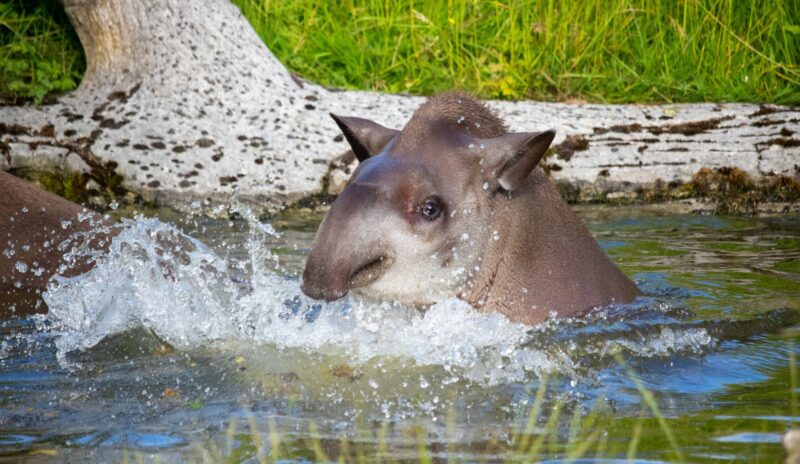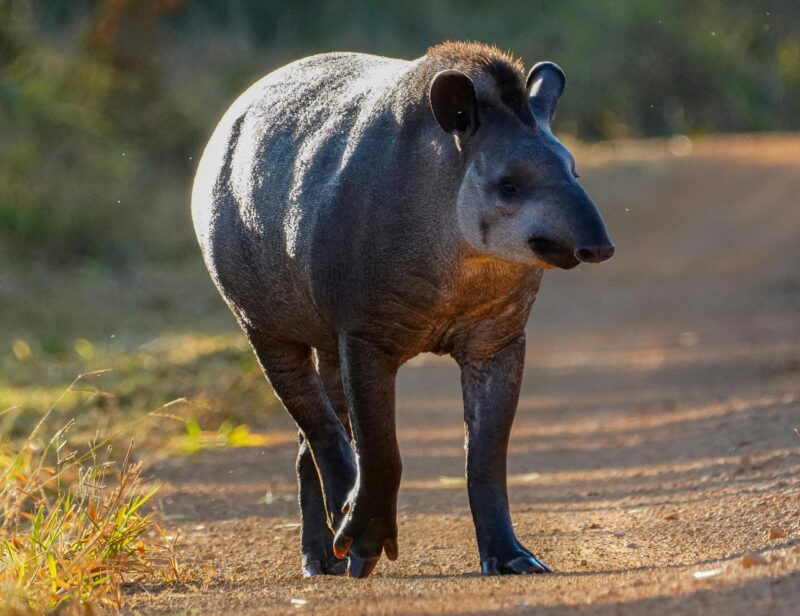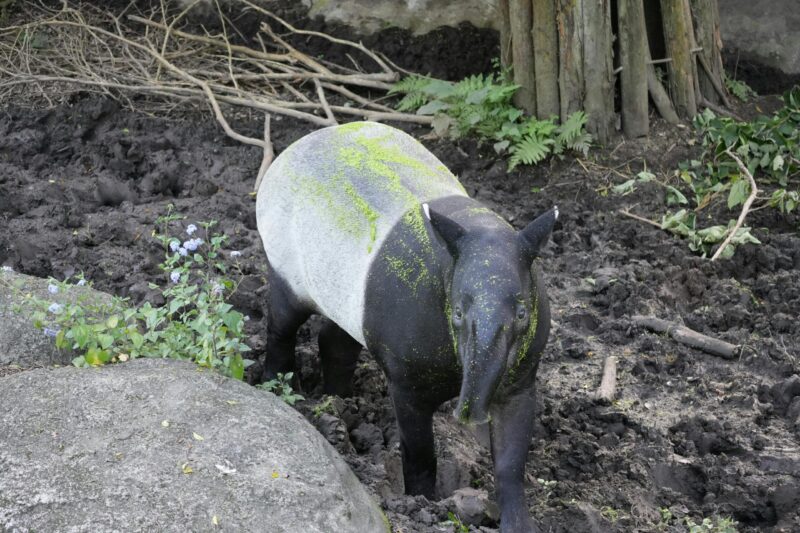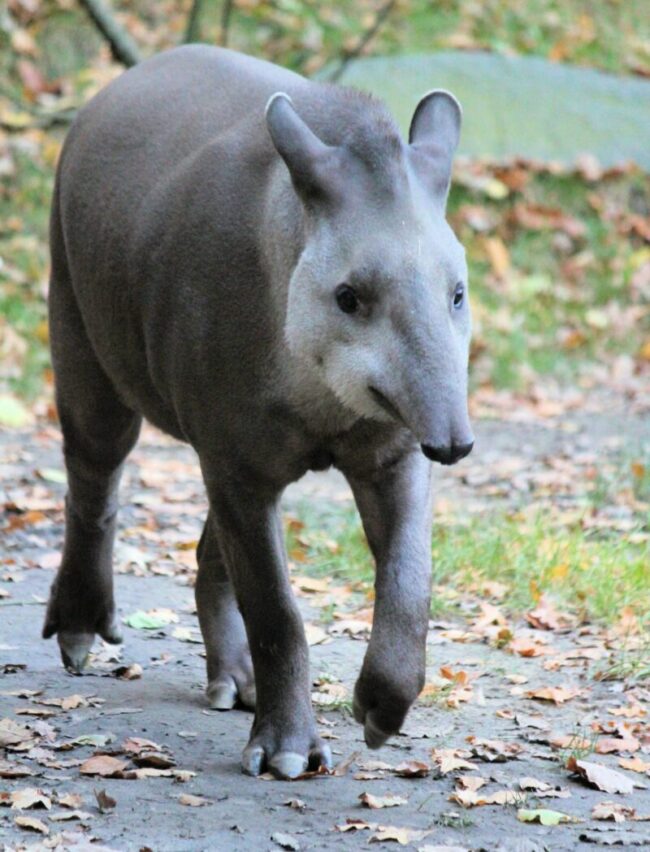Meet the tapir, nature’s adorable mix of elephant and pig, with a nose for adventure and a story you won’t forget! Image via Fernando Maidana/ Pexels.
Science matters. Wonder matters. You matter.
Join our 2025 Donation Campaign today.
At first glance, the tapir looks like an animal straight out of a strange dream. It has the body of a pig and the nose of an elephant, and it radiates a serene air that seems to belong to another time. It’s no wonder that anyone seeing it for the first time tends to stare in a mix of surprise and affection.
Its small eyes shine with curiosity, its little trunk moves from side to side sniffing the air, and its slow, steady steps exude a calm that seems almost incompatible with the noisy tropical forest. Yet behind that gentle appearance hides one of the most important – and least known – animals of the forests of Southeast Asia and the Americas.
The tapir doesn’t seek attention. It lives quietly, away from the noise, moving expertly through the vegetation. But its discretion contrasts sharply with its essential role; without it, many forests would lose the ability to regenerate. The tapir is, quite literally, a gardener of the jungle, a silent sower carrying within its body the promise of new trees.
What kind of creature is a tapir?
The tapir is an herbivorous mammal. And, though it may be hard to believe, it’s a close relative of horses and rhinoceroses! Tapirs belong to the order Perissodactyla. Their bodies are perfectly adapted to life on land, yet they’re also graceful swimmers.
There are four tapir species: three in the Americas (the Amazonian or Brazilian tapir, the Central American tapir and the Andean tapir) and one in Asia (the Malayan tapir). All share a sturdy body, short and strong legs, rounded ears, and a small prehensile trunk, which is their most distinctive feature.
That trunk, tiny compared to an elephant’s, is a handy tool. It helps them grasp and tear leaves, branches and fruit, as well as collect aquatic plants from swamps. How do they reach the bottom? By diving, of course! The trunk serves for drinking, eating, breathing, smelling and even as a snorkel.
Their coat is also quite remarkable and varies by species. The Malayan tapir, the largest of all, sports a striking color contrast – half black, half white – as if wearing a tuxedo vest. The American species, on the other hand, are brown or grayish. And the babies are covered in white spots and stripes, like little fawns. It’s the perfect camouflage among the foliage.
 The tapir is an herbivorous mammal with the body of a pig and the trunk of an elephant, and it’s closely related to rhinos and horses. This one is a young Malayan tapir. Image via Snow Chang/ Pexels.
The tapir is an herbivorous mammal with the body of a pig and the trunk of an elephant, and it’s closely related to rhinos and horses. This one is a young Malayan tapir. Image via Snow Chang/ Pexels.
Let’s dive in!
Tapirs are excellent swimmers and love the water. They spend much of their time near rivers and lagoons, where they can submerge for long periods to cool off, clean their skin, get rid of insects and hide from predators such as jaguars and pumas.
 Tapirs are amazing swimmers and divers. They use their trunk as a snorkel when swimming. And they close their nostrils before diving. Image via Anna Roberts/ Unsplash.
Tapirs are amazing swimmers and divers. They use their trunk as a snorkel when swimming. And they close their nostrils before diving. Image via Anna Roberts/ Unsplash.
They can partially or completely submerge themselves. When swimming, they use their trunk as a snorkel to breathe, and when fully underwater, they close their nostrils and hold their breath. Very impressive!
Their legs are specially adapted for both walking on land and moving in water. Tapirs have four toes on their front feet and three on their back feet, joined by a slight membrane that partially connects them.
This membrane increases surface area while swimming, acting almost like a fin or paddle. Thanks to this, they can propel themselves easily and move with firm, stable strokes.
Their legs are also short, strong and muscular, allowing them to keep their balance on muddy or slippery ground and to climb out of the water silently and with ease.
Surprising tapir facts
Their trunk isn’t just for breathing, drinking, smelling and eating. It’s also a sensitive tool for detecting danger. Tapirs have a very keen sense of smell. Their flexible nose moves in any direction, helping them sense food and threats alike.
Despite their size (some weigh over 550 pounds or 250 kilograms), tapirs are surprisingly agile and can move swiftly through dense vegetation, or even run fast when in danger. They also make curious, high-pitched whistling sounds to communicate with one another.
Tapirs are solitary and peaceful animals. They only become aggressive when cornered or defending their young.
 Even though they can weigh a lot, tapirs are very agile. These magnificent athletes can run, swim and dive. Image via Christopher Borges/ Pexels.
Even though they can weigh a lot, tapirs are very agile. These magnificent athletes can run, swim and dive. Image via Christopher Borges/ Pexels.
The babies: the sweetest thing you’ll see today
Have you ever seen a tapir calf? They are adorable, with markings that resemble a fawn. Their brown bodies are covered in white stripes and spots, which serves as camouflage on the forest floor.
Female tapirs are pregnant for more than 13 months, before giving birth to a single calf. Twins are rare. Like all mammals, tapirs give birth to live young and nurse them with milk.
From birth, the little tapir can stand and follow its mother. It spends its first months very close to her, hidden among the vegetation.
As the calf grows, its stripes and spots fade into the solid color of adults.
Tapir mothers are protective and affectionate. They teach their young how to find food, swim and recognize the sounds of the forest. The calves stay with their mothers for over a year before becoming independent. It’s a slow but steady growth, where they learn the art of patience and prudence … the very virtues that define adult tapirs.
![]() Tapir calves are adorable. They are brown and have white spots and stripes. Image via Pixel mixer/ Pixabay.
Tapir calves are adorable. They are brown and have white spots and stripes. Image via Pixel mixer/ Pixabay.
Home, threats and hope
Unlike many jungle animals, the tapir is neither a predator nor an aggressive competitor. Its ecological role is closer to that of a gardener or a planter. It eats fruits, leaves and tender shoots, and as it digests and moves across great distances, it disperses thousands of seeds throughout the forest. Hence its nickname, the gardener of the jungle.
Many tropical plants depend on tapirs to reproduce. That’s why ecologists consider them a keystone species: wherever there are tapirs, the forest stands a better chance of staying healthy and diverse.
Tapirs live in tropical rainforests, humid forests and swampy areas where they find water and plenty of vegetation. In the Americas, they range from Mexico to northern Argentina, while in Asia, the Malayan tapir lives in Thailand, Sumatra and Malaysia.
Unfortunately, their home is disappearing. Deforestation, poaching and habitat fragmentation have drastically reduced their numbers. Today, all tapir species are classified as vulnerable or endangered by the IUCN. It’s an unfair fate for an animal that harms no one. This gentle giant simply walks, eats fruit and helps the forest breathe.
Still, there is hope. Many organizations are working on conservation and captive breeding programs, and local communities in Latin America and Southeast Asia are beginning to recognize their ecological importance. In some regions, tapirs have even become symbols of natural pride and identity.
 Tapirs feed on fruits, leaves and tender shoots. As they move across great distances, their excretion spreads thousands of seeds throughout the forest. Without them, many forests would lose the ability to regenerate. Image via Snow Chang/ Pexels.
Tapirs feed on fruits, leaves and tender shoots. As they move across great distances, their excretion spreads thousands of seeds throughout the forest. Without them, many forests would lose the ability to regenerate. Image via Snow Chang/ Pexels.
The gentle giant of the jungle
With its calm gaze and gentle stride, the tapir inspires affection. It doesn’t have the fame of the jaguar or the charm of the monkey, but its quiet existence is just as vital. In its slow, steady walk lies a lesson in balance: to live without destroying, to move while leaving life behind.
The tapir doesn’t roar, hunt or compete. Yet it makes a powerful difference to the forest through the spreading of seeds. It’s a peaceful being that, without even trying, keeps the forest alive.
 In the quiet heart of the forest, the tapir moves softly. Gentle, peaceful and profoundly necessary, it’s a humble guardian of balance in the wild. Image via Dusan Veverkolog/ Unsplash.
In the quiet heart of the forest, the tapir moves softly. Gentle, peaceful and profoundly necessary, it’s a humble guardian of balance in the wild. Image via Dusan Veverkolog/ Unsplash.
Bottom line: The tapir might look weird, with the body of a pig and the trunk of an elephant, but this gentle giant helps grow the forest.
Read more: Rhinoceroses: Can modern science save these gentle giants?
Read more: Sloths are our calm and smiley lifeform of the week

Comments are closed.